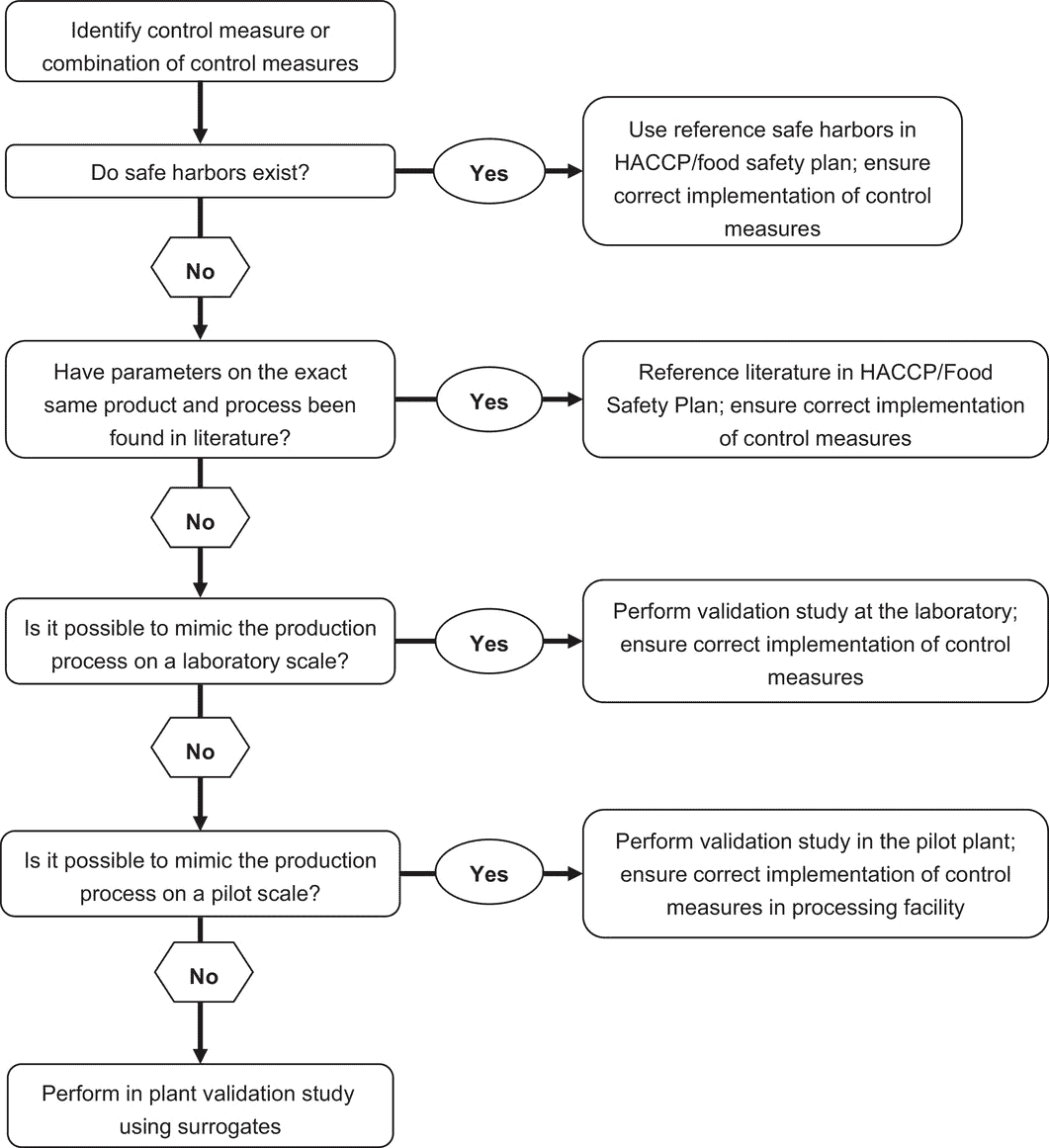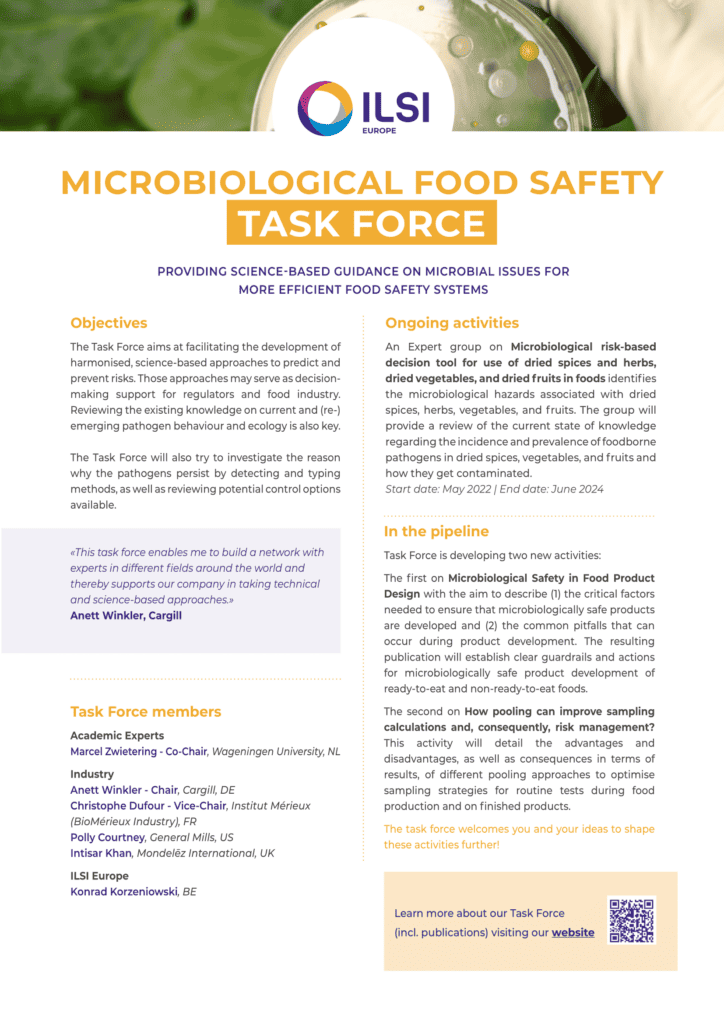Food Control. 2012;26:601-609. Commissioned by the Risk Analysis in Food Microbiology Task Force.
Comprehensive Reviews in Food Science and Food Safety 2021;20,3:2825-2881. Commissioned by the Microbiological Food Safety Task Force.
International Journal of Food Microbiology 2018;285:110-128. Commissioned by the Microbiological Food Safety Task Force.
ILSI Europe Report Series. 2011:1-32. Commissioned by the Risk Analysis in Food Microbiology Task Force.
Trends in Food Science & Technology. 2012; 27(1):12-24. Commissioned by the Risk Analysis in Food Microbiology Task Force.
WP_Query Object
(
[query] => Array
(
[post_type] => publication
[posts_per_page] => 5
[type] =>
[area] =>
[committee] => Risk Analysis in Food Microbiology
[authors] =>
[showtitle] =>
[meta_query] => Array
(
[relation] => AND
)
[tax_query] => Array
(
[0] => Array
(
[taxonomy] => ilsi_committee
[field] => name
[terms] => Risk Analysis in Food Microbiology
)
)
[paged] => 3
[orderby] => title
[order] => DESC
)
[query_vars] => Array
(
[post_type] => publication
[posts_per_page] => 5
[type] =>
[area] =>
[committee] => Risk Analysis in Food Microbiology
[authors] =>
[showtitle] =>
[meta_query] => Array
(
[relation] => AND
)
[tax_query] => Array
(
[0] => Array
(
[taxonomy] => ilsi_committee
[field] => name
[terms] => Risk Analysis in Food Microbiology
)
)
[paged] => 3
[orderby] => title
[order] => DESC
[error] =>
[m] =>
[p] => 0
[post_parent] =>
[subpost] =>
[subpost_id] =>
[attachment] =>
[attachment_id] => 0
[name] =>
[pagename] =>
[page_id] => 0
[second] =>
[minute] =>
[hour] =>
[day] => 0
[monthnum] => 0
[year] => 0
[w] => 0
[category_name] =>
[tag] =>
[cat] =>
[tag_id] =>
[author] =>
[author_name] =>
[feed] =>
[tb] =>
[meta_key] =>
[meta_value] =>
[preview] =>
[s] =>
[sentence] =>
[title] =>
[fields] =>
[menu_order] =>
=>
[category__in] => Array
(
)
[category__not_in] => Array
(
)
[category__and] => Array
(
)
[post__in] => Array
(
)
[post__not_in] => Array
(
)
[post_name__in] => Array
(
)
[tag__in] => Array
(
)
[tag__not_in] => Array
(
)
[tag__and] => Array
(
)
[tag_slug__in] => Array
(
)
[tag_slug__and] => Array
(
)
[post_parent__in] => Array
(
)
[post_parent__not_in] => Array
(
)
[author__in] => Array
(
)
[author__not_in] => Array
(
)
[search_columns] => Array
(
)
[ignore_sticky_posts] =>
[suppress_filters] =>
[cache_results] => 1
[update_post_term_cache] => 1
[update_menu_item_cache] =>
[lazy_load_term_meta] => 1
[update_post_meta_cache] => 1
[nopaging] =>
[comments_per_page] => 50
[no_found_rows] =>
[taxonomy] => ilsi_committee
[term_id] => Risk Analysis in Food Microbiology
)
[tax_query] => WP_Tax_Query Object
(
[queries] => Array
(
[0] => Array
(
[taxonomy] => ilsi_committee
[terms] => Array
(
[0] => Risk Analysis in Food Microbiology
)
[field] => name
[operator] => IN
[include_children] => 1
)
)
[relation] => AND
[table_aliases:protected] => Array
(
[0] => wp_3_term_relationships
)
[queried_terms] => Array
(
[ilsi_committee] => Array
(
[terms] => Array
(
[0] => Risk Analysis in Food Microbiology
)
[field] => name
)
)
[primary_table] => wp_3_posts
[primary_id_column] => ID
)
[meta_query] => WP_Meta_Query Object
(
[queries] => Array
(
)
[relation] => AND
[meta_table] =>
[meta_id_column] =>
[primary_table] =>
[primary_id_column] =>
[table_aliases:protected] => Array
(
)
[clauses:protected] => Array
(
)
[has_or_relation:protected] =>
)
[date_query] =>
[request] =>
SELECT SQL_CALC_FOUND_ROWS wp_3_posts.ID
FROM wp_3_posts LEFT JOIN wp_3_term_relationships ON (wp_3_posts.ID = wp_3_term_relationships.object_id)
WHERE 1=1 AND (
wp_3_term_relationships.term_taxonomy_id IN (24)
) AND ((wp_3_posts.post_type = 'publication' AND (wp_3_posts.post_status = 'publish' OR wp_3_posts.post_status = 'acf-disabled')))
GROUP BY wp_3_posts.ID
ORDER BY wp_3_posts.post_title DESC
LIMIT 10, 5
[posts] => Array
(
[0] => WP_Post Object
(
[ID] => 1695
[post_author] => 12
[post_date] => 2016-06-17 02:19:36
[post_date_gmt] => 2016-06-17 02:19:36
[post_content] =>
[post_title] => Impact of Microbial Distributions on Food Safety I. Factors Influencing Microbial Distributions and Modelling Aspects
[post_excerpt] =>
[post_status] => publish
[comment_status] => closed
[ping_status] => closed
[post_password] =>
[post_name] => impact-of-microbial-distributions-on-food-safety-i-factors-influencing-microbial-distributions-and-modelling-aspects
[to_ping] =>
[pinged] =>
[post_modified] => 2016-06-22 18:36:50
[post_modified_gmt] => 2016-06-22 18:36:50
[post_content_filtered] =>
[post_parent] => 0
[guid] => http://ilsi.eu/?post_type=publication&p=1695
[menu_order] => 0
[post_type] => publication
[post_mime_type] =>
[comment_count] => 0
[filter] => raw
)
[1] => WP_Post Object
(
[ID] => 9217
[post_author] => 343
[post_date] => 2021-05-25 07:51:58
[post_date_gmt] => 2021-05-25 07:51:58
[post_content] =>
FOOD RELATED CONTAMINANTS
This guidance contains a set of approaches to evaluate available data on target pathogens to support the use of validation studies.
In order to ensure safety of food, a number of control measures need to be implemented by the industry. Validation studies are used to provide evidence that the implemented measures are actually capable of controlling the identified hazard.
Potential to limit the occurrence of discrepancies in the information.
By utilising this guidance, actors involved can identify product and process factors that are essential when designing a validation study. They can thus, select the criteria for identifying an appropriate target pathogen or surrogate organism for a food product and process validation.
Designed for a wide range of food-production professionals.
The document helps food manufacturers, processors, and food safety professionals to better understand, plan, and perform validation studies. It offers an overview of the choices and key technical elements of a validation plan, the necessary preparations including assembling the validation team and establishing prerequisite programs, and the elements of a validation report.

Decision tree to support the decision of when and which validation study approach is most applicable
There is a great interest in the food industry to perform validations in a manner that would be accepted by all parties involved, for example, authorities and customers.
To download this open-access article, please click here.
Scientific abstract
Expand
Food manufacturers are required to obtain scientific and technical evidence that a control measure or combination of control measures is capable of reducing a significant hazard to an acceptable level that does not pose a public health risk under normal conditions of distribution and storage. A validation study provides evidence that a control measure is capable of controlling the identified hazard under a worst-case scenario for process and product parameters tested. It also defines the critical parameters that must be controlled, monitored, and verified during processing. This review document is intended as guidance for the food industry to support appropriate validation studies, and aims to limit methodological discrepancies in validation studies that can occur among food safety professionals, consultants, and third-party laboratories. The document describes product and process factors that are essential when designing a validation study, and gives selection criteria for identifying an appropriate target pathogen or surrogate organism for a food product and process validation. Guidance is provided for approaches to evaluate available microbiological data for the target pathogen or surrogate organism in the product type of interest that can serve as part of the weight of evidence to support a validation study. The document intends to help food manufacturers, processors, and food safety professionals to better understand, plan, and perform validation studies by offering an overview of the choices and key technical elements of a validation plan, the necessary preparations including assembling the validation team and establishing prerequisite programs, and the elements of a validation report.
Keywords
Expand
critical control points, inactivation, pathogen, preventive control, process validation
Range of nonthermal processing techniques in this study:
10
+ the critical parameters for their application and examples.
Key factors to consider related to the product
8
They are used to determine process efficiency and whether the target pathogen is capable of growth in product.
Food categories for which examples of common pathogens of concern are given
19
+ the situations posing increased risk.
Validation studies are necessary even when safe harbors are available to ensure correct implementation of control measures.
[post_title] => Guidance on validation of lethal control measures for foodborne pathogens in foods
[post_excerpt] =>
[post_status] => publish
[comment_status] => closed
[ping_status] => closed
[post_password] =>
[post_name] => guidance-on-validation-of-lethal-control-measures-for-foodborne-pathogens-in-foods
[to_ping] =>
[pinged] =>
[post_modified] => 2022-08-22 13:02:32
[post_modified_gmt] => 2022-08-22 13:02:32
[post_content_filtered] =>
[post_parent] => 0
[guid] => https://ilsi.eu/?post_type=publication&p=9217
[menu_order] => 0
[post_type] => publication
[post_mime_type] =>
[comment_count] => 0
[filter] => raw
)
[2] => WP_Post Object
(
[ID] => 5717
[post_author] => 24
[post_date] => 2018-08-08 12:24:25
[post_date_gmt] => 2018-08-08 12:24:25
[post_content] =>
[post_title] => Foodborne Viruses: Detection, Risk Assessment, and Control Options in Food Processing
[post_excerpt] =>
[post_status] => publish
[comment_status] => closed
[ping_status] => closed
[post_password] =>
[post_name] => foodborne-viruses-detection-risk-assessment-and-control-options-in-food-processing
[to_ping] =>
[pinged] =>
[post_modified] => 2021-06-18 12:06:10
[post_modified_gmt] => 2021-06-18 12:06:10
[post_content_filtered] =>
[post_parent] => 0
[guid] => http://ilsi.eu/?post_type=publication&p=5717
[menu_order] => 0
[post_type] => publication
[post_mime_type] =>
[comment_count] => 0
[filter] => raw
)
[3] => WP_Post Object
(
[ID] => 1709
[post_author] => 12
[post_date] => 2016-06-18 02:44:17
[post_date_gmt] => 2016-06-18 02:44:17
[post_content] =>
[post_title] => Food Safety Management Tools, 2nd Edition
[post_excerpt] =>
[post_status] => publish
[comment_status] => closed
[ping_status] => closed
[post_password] =>
[post_name] => food-safety-management-tools-2nd-edition
[to_ping] =>
[pinged] =>
[post_modified] => 2016-06-22 18:39:52
[post_modified_gmt] => 2016-06-22 18:39:52
[post_content_filtered] =>
[post_parent] => 0
[guid] => http://ilsi.eu/?post_type=publication&p=1709
[menu_order] => 0
[post_type] => publication
[post_mime_type] =>
[comment_count] => 0
[filter] => raw
)
[4] => WP_Post Object
(
[ID] => 1646
[post_author] => 12
[post_date] => 2016-06-15 15:23:37
[post_date_gmt] => 2016-06-15 15:23:37
[post_content] =>
[post_title] => ‘Omics’ Technologies in Quantitative Microbial Risk Assessment
[post_excerpt] =>
[post_status] => publish
[comment_status] => closed
[ping_status] => closed
[post_password] =>
[post_name] => omics-technologies-in-quantitative-microbial-risk-assessment
[to_ping] =>
[pinged] =>
[post_modified] => 2016-06-22 18:33:17
[post_modified_gmt] => 2016-06-22 18:33:17
[post_content_filtered] =>
[post_parent] => 0
[guid] => http://ilsi.eu/?post_type=publication&p=1646
[menu_order] => 0
[post_type] => publication
[post_mime_type] =>
[comment_count] => 0
[filter] => raw
)
)
[post_count] => 5
[current_post] => -1
[before_loop] =>
[in_the_loop] =>
[post] => WP_Post Object
(
[ID] => 1695
[post_author] => 12
[post_date] => 2016-06-17 02:19:36
[post_date_gmt] => 2016-06-17 02:19:36
[post_content] =>
[post_title] => Impact of Microbial Distributions on Food Safety I. Factors Influencing Microbial Distributions and Modelling Aspects
[post_excerpt] =>
[post_status] => publish
[comment_status] => closed
[ping_status] => closed
[post_password] =>
[post_name] => impact-of-microbial-distributions-on-food-safety-i-factors-influencing-microbial-distributions-and-modelling-aspects
[to_ping] =>
[pinged] =>
[post_modified] => 2016-06-22 18:36:50
[post_modified_gmt] => 2016-06-22 18:36:50
[post_content_filtered] =>
[post_parent] => 0
[guid] => http://ilsi.eu/?post_type=publication&p=1695
[menu_order] => 0
[post_type] => publication
[post_mime_type] =>
[comment_count] => 0
[filter] => raw
)
[comment_count] => 0
[current_comment] => -1
[found_posts] => 15
[max_num_pages] => 3
[max_num_comment_pages] => 0
[is_single] =>
[is_preview] =>
[is_page] =>
[is_archive] => 1
[is_date] =>
[is_year] =>
[is_month] =>
[is_day] =>
[is_time] =>
[is_author] =>
[is_category] =>
[is_tag] =>
[is_tax] => 1
[is_search] =>
[is_feed] =>
[is_comment_feed] =>
[is_trackback] =>
[is_home] =>
[is_privacy_policy] =>
[is_404] =>
[is_embed] =>
[is_paged] => 1
[is_admin] =>
[is_attachment] =>
[is_singular] =>
[is_robots] =>
[is_favicon] =>
[is_posts_page] =>
[is_post_type_archive] =>
[query_vars_hash:WP_Query:private] => d439136bff8ce3607e2358f77af25dab
[query_vars_changed:WP_Query:private] =>
[thumbnails_cached] =>
[allow_query_attachment_by_filename:protected] =>
[stopwords:WP_Query:private] =>
[compat_fields:WP_Query:private] => Array
(
[0] => query_vars_hash
[1] => query_vars_changed
)
[compat_methods:WP_Query:private] => Array
(
[0] => init_query_flags
[1] => parse_tax_query
)
)


